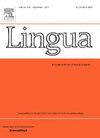Placeholders in written language: The case of Japanese kō and otsu
IF 1.3
3区 文学
0 LANGUAGE & LINGUISTICS
引用次数: 0
Abstract
A communicator is sometimes unable or unwilling to produce a particular expression. One of the lexical resources for overcoming such word-formulation difficulties is the use of placeholders like whatchamacallit and you-know-what. Whilst recent years have seen a proliferation of research on placeholders across diverse languages, prior studies have largely focussed on spoken language, with little attention paid to their use in writing. This paper reveals that Japanese has placeholders that appear almost exclusively in written language, predominantly in legal texts. First, we describe the distributional and grammatical properties of the placeholders kō and otsu through a theory-neutral analysis of data retrieved from The Balanced Corpus of Contemporary Written Japanese. Second, building on this descriptive foundation, we propose a cognitive account of their semantic and pragmatic aspects within the framework of Relevance Theory. We argue that kō and otsu encode procedural meaning and demonstrate how specific interpretations, both explicit and implicit, arise from the interaction among procedural meaning, contextual assumptions, and pragmatic principles. The present work advances the scholarship of placeholders by providing the first detailed account of placeholders in written language and by developing a semantic–pragmatic integrated approach to their contextual interpretation.
书面语言中的占位符:日语中的kkui和otsu
沟通者有时不能或不愿表达某种特定的表达。克服这种词汇表达困难的词汇资源之一是使用占位符,如whatchamacallit和you-know-what。虽然近年来对不同语言中占位符的研究激增,但之前的研究主要集中在口语上,很少关注它们在写作中的使用。本文揭示了日语的占位符几乎只出现在书面语言中,主要出现在法律文本中。首先,我们通过对《当代书面日语平衡语料库》中检索到的数据进行理论中立的分析,描述了占位符khi和otsu的分布和语法特性。其次,在此描述基础上,我们在关联理论的框架内提出了对其语义和语用方面的认知解释。我们认为,kue和otsu编码程序意义,并展示了显性和隐性的具体解释是如何从程序意义、语境假设和语用原则之间的相互作用中产生的。目前的工作通过提供书面语言中占位符的第一个详细说明,并通过开发一种语义-语用综合方法来解释其上下文,从而推进了占位符的学术研究。
本文章由计算机程序翻译,如有差异,请以英文原文为准。
求助全文
约1分钟内获得全文
求助全文
来源期刊

Lingua
Multiple-
CiteScore
2.50
自引率
9.10%
发文量
93
审稿时长
24 weeks
期刊介绍:
Lingua publishes papers of any length, if justified, as well as review articles surveying developments in the various fields of linguistics, and occasional discussions. A considerable number of pages in each issue are devoted to critical book reviews. Lingua also publishes Lingua Franca articles consisting of provocative exchanges expressing strong opinions on central topics in linguistics; The Decade In articles which are educational articles offering the nonspecialist linguist an overview of a given area of study; and Taking up the Gauntlet special issues composed of a set number of papers examining one set of data and exploring whose theory offers the most insight with a minimal set of assumptions and a maximum of arguments.
 求助内容:
求助内容: 应助结果提醒方式:
应助结果提醒方式:


